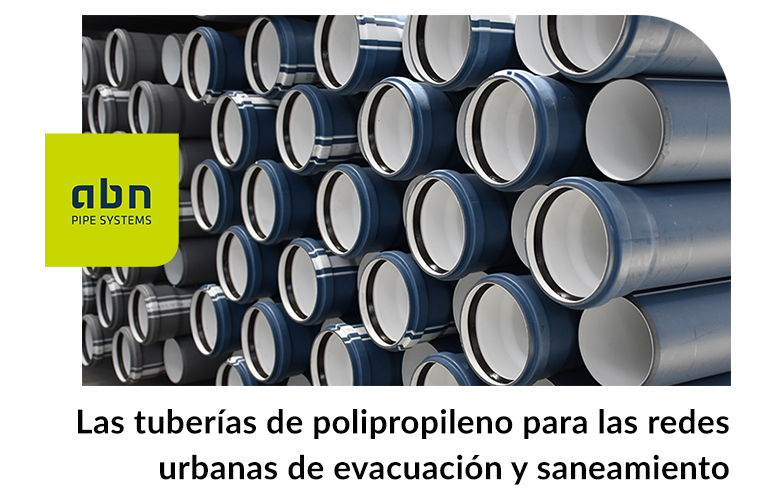La red de evacuación y saneamiento de las ciudades desempeña un papel fundamental en la promoción de la salud pública, la protección del medio ambiente y el bienestar general de nuestras ciudades. Su correcto mantenimiento y la inversión continua en su mejora son fundamentales para garantizar su eficiencia y sostenibilidad a largo plazo.
En este artículo profundizaremos en las ventajas de las tuberías de polipropileno para las redes de evacuación y saneamiento de las ciudades, poniendo el foco en sus características técnicas, su instalación y su regulación.
- ¿Qué son las tuberías de evacuación y para qué se utilizan?
- Materiales principales de las tuberías de evacuación
- Ventajas de las tuberías de polipropileno para las redes de evacuación
- ¿Qué norma aplica a las tuberías de PP para evacuación?
- ¿Qué es la rigidez anular?
- ¿Qué significa el código B y BD en una tubería de evacuación?
- ¿Qué significa que una tubería sea libre de halógenos?
- ¿Qué es la evacuación insonorizada?
- Método de unión de las tuberías de polipropileno para desagüe
- Certificaciones ambientales para las tuberías de evacuación
- Las tuberías de polipropileno: una solución eficaz para redes de evacuación
¿Qué son las tuberías de evacuación y para qué se utilizan?
Según el código técnico de edificación, todos los edificios deben disponer de medios adecuados para extraer las aguas residuales generadas en ellos. De esto precisamente se ocupa la red de tuberías de evacuación que conducen hacia el exterior las aguas sin causar molestias, humedades, ruidos ni malos olores a los ocupantes de las viviendas. En general, este tipo de tuberías se emplean para:
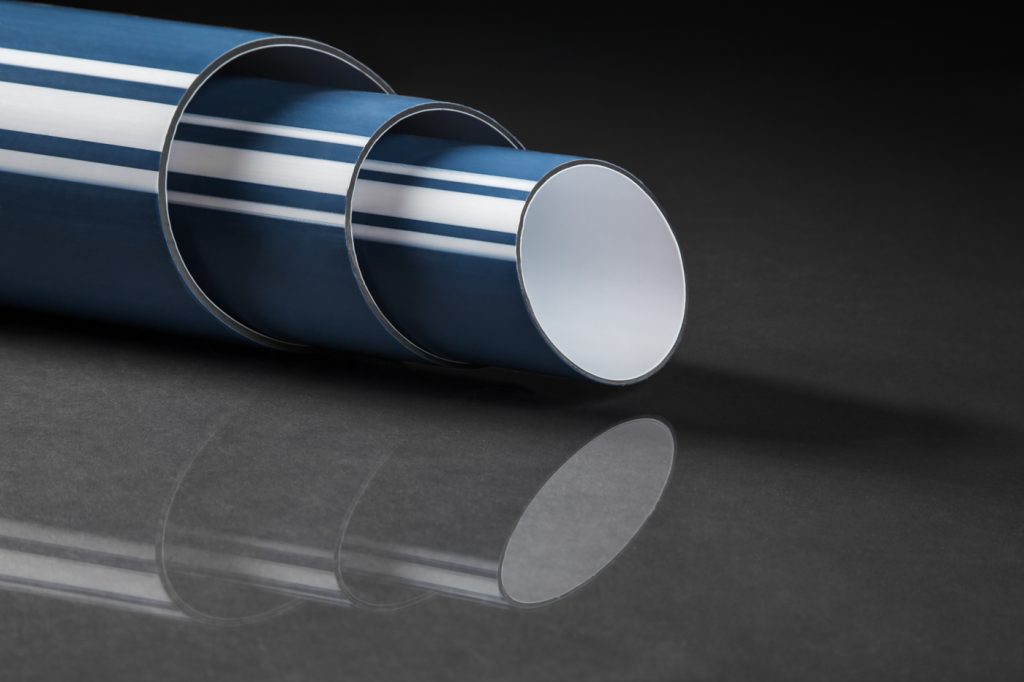
- Evacuación de aguas pluviales: En la red de tuberías se canaliza el agua de lluvia desde los techos y superficies impermeabilizadas de los edificios hacia el sistema de drenaje pluvial. Esto ayuda a prevenir inundaciones y daños estructurales causados por la acumulación de agua en techos y áreas circundantes.
- Evacuación de aguas residuales: Las tuberías de evacuación transportan aguas residuales, como las provenientes de inodoros, lavabos, duchas y otros desagües, desde el interior del edificio hacia la red de alcantarillado municipal o hacia un sistema de tratamiento de aguas residuales en el caso de sistemas autónomos, como fosas sépticas.
- Evacuación de aguas residuales a baja y alta temperatura: Gracias a su resistencia a la temperatura, las tuberías PP están indicadas para la evacuación de aguas residuales a alta y baja temperatura en laboratorios, lavanderías, cocinas, autoclaves y desagües de tipo industrial.
Materiales principales de las tuberías de evacuación
La tubería plástica de evacuación y saneamiento más utilizada es la de policloruro de vinilo, también conocido como PVC, que lleva más de 60 años empleándose en sistemas tanto subterráneos como sobre la superficie. Ahora bien, para una red de evacuación de aguas residuales y pluviales, el polipropileno (PP) es el mejor material que se puede emplear en la actualidad, gracias a sus particulares características técnicas y su capacidad de ser reciclado.
- Tuberías de PVC: El cloruro de polivinilo, o PVC, de pared compacta o estructurada, es uno de los materiales más usados para la fabricación de tuberías de drenaje, suministro de agua y conductos eléctricos. El PVC presenta una gran resistencia a la tracción y un módulo de elasticidad relativamente alto. Además, cuentan con un bajo mantenimiento, una integridad de unión excepcional y un alto factor de seguridad. Esto ofrece al instalador beneficios como una mayor durabilidad y resistencia anti-grietas o fisuras.
- Tuberías de polipropileno: Fabricadas en polipropileno, de pared compacta o con un sistema de pared interior que absorbe los ruidos del fluido que circula por el tubo, se caracterizan por ser muy resistentes y se pueden utilizar a altas temperaturas. Permiten no solo transportar agua fría y caliente, son también resistentes a la abrasión de muchos reactivos o sustancias químicas como el ácido sulfúrico, sosa cáustica, entre otros; los cual favorece a la versatilidad de uso en diferentes industrias. Además, cuentan con la ventaja de tener un bajo peso, buen rendimiento anticorrosión, ausencia de fisuras, una larga vida útil y gracias al sistema de termofusión, garantizar uniones monolíticas. Por otro lado, son flexibles y tienen una gran versatilidad que puede adaptarse en cualquier instalación. Estos tubos insonorizados, se suelen instalar en viviendas, hoteles o edificios singulares.
Ventajas de las tuberías de polipropileno para las redes de evacuación
El polipropileno (PP) ha ganado terreno en el ámbito de las infraestructuras urbanas gracias a su versatilidad y eficiencia.
- Mayor reciclabilidad: El PP es reciclable, lo que lo convierte en una opción más sostenible y respetuosa con el medio ambiente. Esta característica es fundamental en un mundo cada vez más consciente de la importancia de la economía circular.
- Resistencia a la temperatura: Los sistemas de PP pueden soportar temperaturas desde los -20ºC hasta 97ºC, garantizando su funcionalidad en una amplia gama de entornos y condiciones climáticas.
- Mejor rigidez anular: Con una rigidez anular superior (SN>6), los tubos de PP ofrecen una mayor resistencia a las cargas externas, asegurando su integridad estructural a lo largo del tiempo.
- Mejor comportamiento frente al fuego: Tanto los tubos de saneamiento y evacuación fabricados en PP como los tubos de PVC cuentan con una clasificación de reacción al fuego B-S1, D0 lo que implica que el material tiene una producción de humos baja y que al arder no se desprenden gotas o partículas que puedan caer sobre otros elementos.
- Libre de halógenos: El PP es un material libre de halógenos, lo que significa que no emite gases tóxicos ni corrosivos en caso de incendio, protegiendo tanto a las personas como al medio ambiente.
- Insonorización: Las tuberías de PP están diseñadas para reducir el ruido, esto se consigue gracias a su estructura tricapa, con capa intermedia con refuerzo mineral que consigue una excelente absorción contra choques y vibraciones, cumpliendo con los estándares de protección acústica en edificaciones. Esto contribuye al confort y bienestar de los residentes.
- Durabilidad y resistencia química: Las tuberías de PP para saneamiento tienen una alta resistencia química (PH1-PH13), garantizando su durabilidad y rendimiento óptimo en aplicaciones urbanas e industriales.
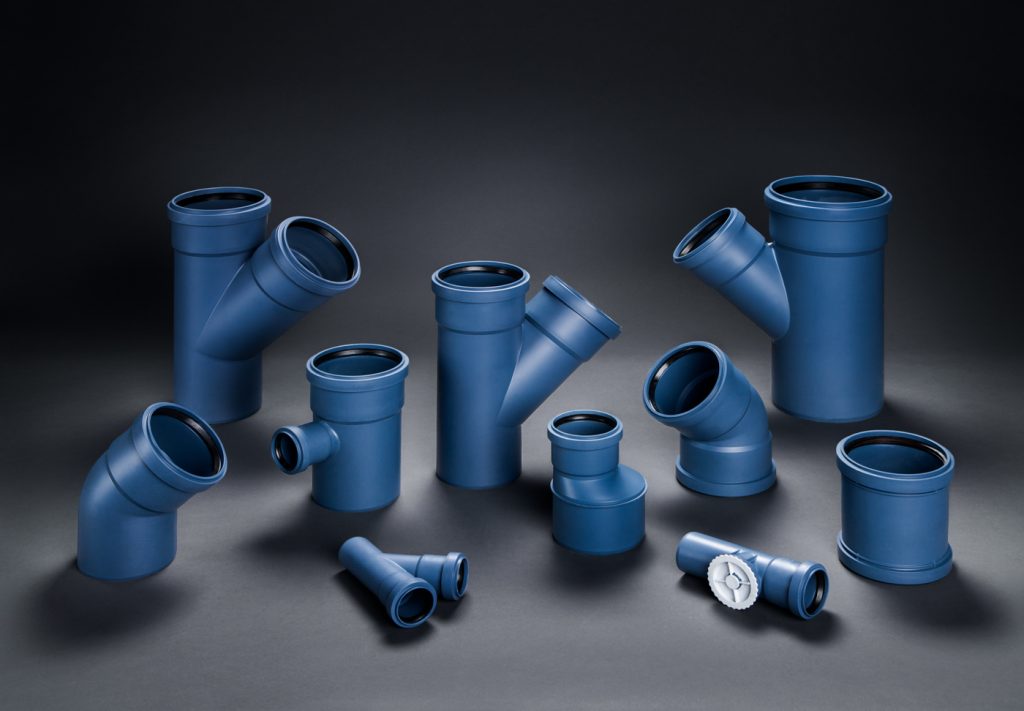
¿Qué norma aplica a las tuberías de PP para evacuación?
Los sistemas PP son fabricados conforme a la Norma UNE EN 1451 para canalización en materiales plásticos y evacuación de aguas residuales en el interior de la estructura de los edificios. Estos sistemas están especialmente indicados para la evacuación de aguas residuales domésticas en viviendas y edificios públicos con particular riesgo ante el fuego, aprovechando además las ventajas proporcionadas por los sistemas fonoabsorbentes.
¿Qué es la rigidez anular?
La rigidez anular es la resistencia al aplastamiento de un tubo o accesorio bajo una carga mecánica externa de efecto radial -condición definida en la norma UNE-EN-ISO 9969-.
En una red de saneamiento sin presión interior, los tubos están sometidos a unas cargas externas debido al material de relleno de la zanja, a las cargas móviles del tráfico, etc. Estas cargas provocan que el tubo tienda a deformarse, lo que origina unas tensiones de compresión en la parte interior del tubo y de tracción en la parte exterior que han de ser soportadas por la estructura del tubo.
Mientras que en tubos de PVC la rigidez anular es estándar (SN 4), en los tubos de PP se ha mejorado la formulación de su capa intermedia, otorgándole una mayor rigidez (SN>6).
Además, los tubos de saneamiento en PP cuentan con un sistema de unión por junta elástica, confiriéndoles una mayor rigidez frente a los sistemas de unión por soldadura del PVC. En el caso del PVC, es necesario manguitos de dilatación, ya que al tener uniones encoladas se puede producir una rotura en las mismas. Por el contrario, en el del PP no, ya que las copas del tubo absorben las dilataciones del sistema.
¿Qué significa el código B y BD en una tubería de evacuación?
Este código responde a la clasificación que la normativa les otorga a las tuberías de evacuación en función de su aplicación:
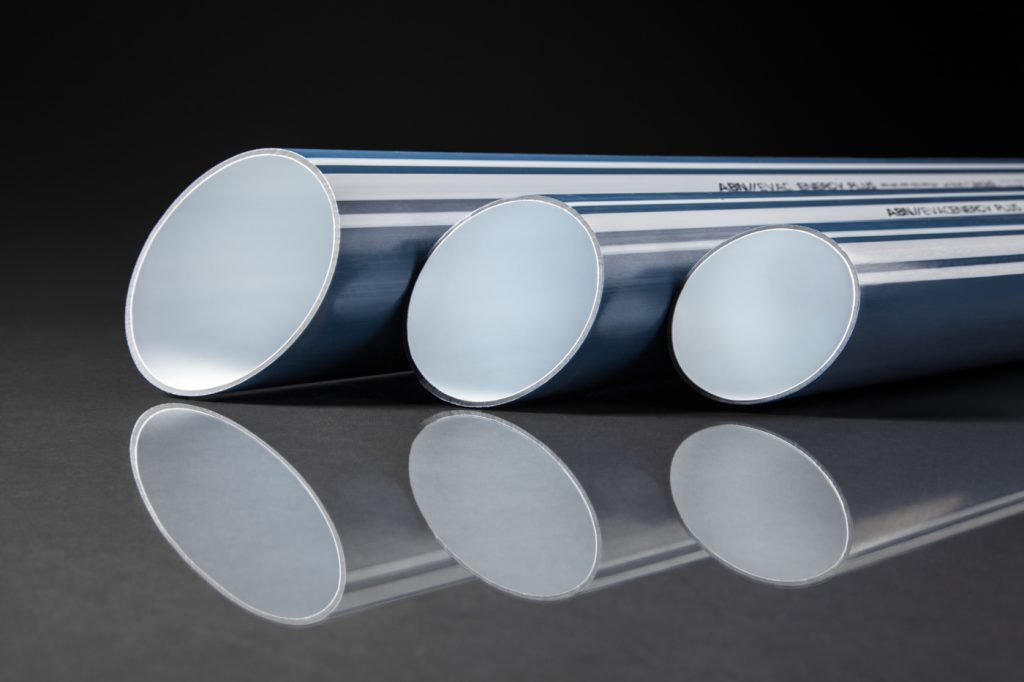
- Serie B: Tubos y accesorios instalados sobre forjados o paramentos verticales en el interior de edificios (red interior y bajantes).
- Serie D: Tubos enterrados dentro y hasta 1 metro de la proyección en planta del edificio, para ser conectados a la red de saneamiento.
- Serie BD: Tubos y accesorios que se pueden utilizar indistintamente en cualquier aplicación anterior.
¿Qué significa que una tubería sea libre de halógenos?
La seguridad en instalaciones y construcciones es una preocupación constante, especialmente cuando se trata de materiales expuestos a posibles incendios. En este sentido, comprender qué implica que una tubería sea libre de halógenos es fundamental.
Los halógenos son algunos elementos del grupo VII A de la tabla periódica: Flúor, Cloro, Bromo, Téneso y Yodo. Todos ellos son elementos tan reactivos que no se encuentran libres en la naturaleza, sino siempre mezclados con otros.
El resultado de la combustión de materiales halógenos es gran cantidad de humos corrosivos, tóxicos y opacos.
Así, las tuberías libres de halógenos no contienen ninguno de esos elementos y se comportan mucho mejor en caso de incendio que el PVC (que contiene cloro) teniendo características mecánicas muy similares. De ahí que se conozcan los tubos sin halógenos como de alta seguridad frente al fuego.
¿Qué es la evacuación insonorizada?
La mayoría de las quejas sobre los ruidos en edificios provienen de problemas con la insonorización de las bajantes para la evacuación de aguas.
En España, el artículo 14 del Documento Básico HR (Protección frente al ruido) del Código Técnico de la Edificación (CTE) advierte que “con la finalidad de limitar el riesgo de molestias a los usuarios de las viviendas, los elementos de las instalaciones reducirán la emisión de ruidos durante su funcionamiento, afectando tanto a la obra nueva como a la obra de rehabilitación y reforma”. Además, para una vivienda, hospital o centro educativo, el Documento Básico HR del CTE permite en el recinto un máximo de 45 dB.
Las tuberías de evacuación insonorizada han sido diseñadas específicamente para solucionar la evacuación de fluidos en redes de tuberías con las más altas exigencias en la reducción de niveles acústicos. Un correcto sistema de evacuación insonorizada resulta necesario para alcanzar el confort acústico que las personas demandan.
Teniendo en cuenta la cifra mencionada anteriormente, los valores de ruido emitidos por los sistemas de evacuación insonorizados quedan muy por debajo del máximo permitido por el CTE, lo cual garantiza un gran confort en viviendas y una significativa reducción de las molestias ocasionadas por el desagüe de fluidos.
Método de unión de las tuberías de polipropileno para desagüe
Muchos tubos en el mercado todavía utilizan uniones roscadas, juntas soldadas o mecánicas, técnicas que si bien han sido realmente útiles y funcionales han quedado relegadas al pasado. La especialización de los materiales ha permitido que las nuevas tuberías de PP utilicen juntas elásticas que son claves para la estanqueidad del agua. Una copa extralarga y una junta especialmente diseñada hacen que la unión resultante sea totalmente estanca y fiable, garantizando el perfecto funcionamiento de la red incluso con depresiones de 0,5 bar y con deformaciones superiores al 30%.
Esta combinación de longitud y material optimiza el funcionamiento de las tuberías. Algunas de las ventajas de la junta elástica con respecto a tecnologías anteriores son:
- Evita los depósitos de suciedad en la zona de la junta y requiere poco esfuerzo de aplicación y relevo gracias a su ángulo de arranque.
- Es hermética y elástica en caso de desviación del ángulo o deformación de la tubería, por lo que tiene una mayor protección ante la deformación.
- Las juntas elásticas tienen un perfil exacto de filtración, lo cual facilita la inserción de la tubería e impide soltar la junta labial.
- Ofrece una mayor optimización de la zona exterior de la junta, de ese modo se tiene una clara mejoría de la presión de superficie y de variación del ángulo en la copa.
Certificaciones ambientales para las tuberías de evacuación
Para asegurar la sostenibilidad y el bajo impacto ambiental, a este tipo de tuberías también le son aplicables las certificaciones ambientales de producto reconocidas internacionalmente, como son:
- Cradle to Cradle (C2C): Es una solución integral para evaluar, optimizar y verificar todos los aspectos del diseño y fabricación de productos al evaluar la seguridad, circularidad y responsabilidad de los productos. Este sello impulsa los productos de innovación para la economía circular al proporcionar un marco para diseñar materiales y productos que sean seguros, circulares y se fabriquen de manera responsable.
- Declaración Ambiental de Producto (EPD): Es un documento que informa de manera cuantificable y verificable sobre el impacto ambiental de un producto, así como aporta datos técnicos sobre su fabricación, ofreciendo al cliente información veraz y verificada.
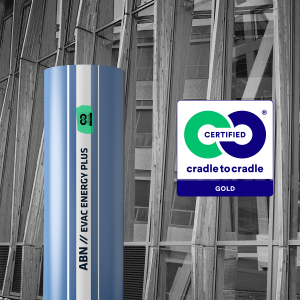
Además, estas certificaciones puntúan en los estándares de importantes sellos de producto que también clarifican el impacto medioambiental, promoviendo el uso de materiales con menor impacto. Los sellos ambientales más conocidos para certificar la sostenibilidad son BREEAM y LEED. Por su parte, las casas y edificios construidos según los estándares Passvivahus reducen en un 75% las necesidades de calefacción y de refrigeración, y el resto de energía puede ser cubierta fácilmente con energías renovables.
Las tuberías de polipropileno: una solución eficaz para redes de evacuación
Al adoptar tecnologías innovadoras, estamos construyendo un futuro más limpio, seguro y resiliente para nuestras ciudades y comunidades. La correcta elección y mantenimiento de las tuberías de evacuación permite la eliminación y transporte de las aguas residuales, evitando su acumulación y previniendo posibles problemas de salud pública que afecten al bienestar urbano.
La apuesta por soluciones ecoamigables para la construcción de los tubos, como en el caso de las tuberías de polipropileno, contribuye a la protección medioambiental y al confort de las comunidades. La versatilidad y eficiencia de este material lo han posicionado como un referente en el ámbito de las infraestructuras urbanas en un mundo cada vez más comprometido con la sostenibilidad.
